Top 10 Places to Explore in New York City
- Jacqui
- Nov 5, 2018
- 17 min read
Ahh ... New York City! What an amazing city! Everyone wants to visit and some stay because they fall in love with The Big Apple! Here's a little history of this fascinating city.
An Italian, Giovanni da Verrazano discovered New York Harbor in 1524. Giovanni da Verrazzano was an Italian explorer of North America, in the service of King Francis I of France.
Then in 1609, Henry Hudson, an English sea explorer and navigator in the early 17th century, explored the region around the modern New York metropolitan area, looking for a Northwest Passage to Asia while in the employment of the Dutch East India Company. He explored the Hudson River, which was named after him, and thereby laid the foundation for Dutch colonization of the region.
In 1626 the first governor, Peter Minuit, bought the island of Manhattan from the Native Americans. Minuit is generally credited with orchestrating the purchase of Manhattan Island for the Dutch from the Native Americans, which later became the city of New Amsterdam, modern-day New York City.
The Dutch built a little town on the southern tip of Manhattan Island and called it New Amsterdam. In New Amsterdam buildings were made of wood but in time houses of stone or brick were erected. The early settlers were Dutch Belgium, French and English people. The first Jews arrived in New Amsterdam in 1654. Meanwhile the first black slaves arrived in 1628. The Dutch lost New Amsterdam to the English in 1674. This time it was renamed New York in honor of the Duke of York, brother of King Charles II.
Wall Street
1653 a wall was built across Manhattan Island to protect the little town of New Amsterdam. The street next to it was called Wall Street. The Bank of New York was founded in 1784. Until 1792 trading in stocks and shares took place informally in and around Wall Street. However in that year a group of merchants signed an agreement to only deal with each other. That was the beginning of the New York Stock Exchange.
Harlem
In 1658 Dutch farmers built a village they called Nieuw Haarlem or New Harlem after a town in Holland. However in 1835 fire destroyed much of the old district of New York but it was soon rebuilt. In 1837 Harlem was connected to New York by railway. As a result it grew rapidly.
Trinity Church
Trinity Church was dedicated in 1698 and was erected at the head of Wall Street facing the Hudson River. The first Trinity Church building was destroyed in the Great Fire of 1776 during the Revolutionary War. St. Paul’s Chapel was saved by a bucket brigade that ran from the Hudson River up to the chapel roof. After the war Trinity, and all Anglican churches in the former colonies, legally separated from the Church of England and became the Episcopal Church. Following his inauguration as President of the United States in 1789, George Washington prayed in St. Paul’s Chapel. The next year, the second Trinity Church was completed. This church faced Wall Street and was both longer and wider than the first. The new steeple soared to a height of 200 feet. President Washington and members of his government were regular worshipers in the new Trinity building during the brief period New York City was the capital of the United States. Notable parishioners from this time include John Jay and Alexander Hamilton.
Battery Park
In 1635 the Dutch built a fort called Fort Amsterdam. The British later renamed it Fort George. In 1693, 92 cannons were installed to protect New York. The area became known as the Battery and now Battery Park. In 1811 a new fort called West Battery replaced Fort George. In 1815 it was renamed Castle Clinton after the mayor DeWitt Clinton.
St. Paul's Chapel
By 1700 New York had a population of almost 5,000 and it continued to grow rapidly and by 1766 the populations was nearing 20,000. Trinity Church built St. Paul’s Chapel just up Broadway at the corner of Vesey Street to accommodate the growing population. Today, St. Paul’s is the only colonial-era church remaining in Manhattan, and the oldest public building in continuous use. Upon completion in 1766, it was the tallest building in New York City and it survived the Great New York City Fire of 1776 when a quarter of New York City, including Trinity Church, burned following the British capture of the city after the Battle of Long Island during the American Revolutionary War.
Columbia University
Columbia University is a private Ivy League research university in Upper Manhattan, New York City. It was established in 1754 as King's College by royal charter of George II of Great Britain.
Port of New York
In the 18th century the main industry in New York was milling and grain was ground into flour by windmills. New York Merchants traded with Britain and the West Indies. There was a shipbuilding industry in New York and the first shipyard opened in 1720. New York boomed as a port. In 1807 Robert Fulton launched a steamboat on the Hudson River. In 1818 ship owners in New York formed the Black Ball Line, the first shipping line between New York and Liverpool.
Manhattan
1807 the governor of the state of New York appointed a commission to draw up a plan for the city. The commission reported in 1811. The plan proposed that new streets should be laid out on a grid pattern. There would be 12 avenues running north to south and 155 streets running east to west. As New York City grew the grid pattern spread north across Manhattan. By 1820 New York had become the largest city in the US with a population of 123,000. By 1840 New York had a population of 312,000 and by 1860 it had 813,000 inhabitants. Today there are over 8.5 million living in New York.
Erie Canal
However the port of New York really boomed when the Erie Canal was built. It allowed goods to be transported from the coast to the interior cheaply and quickly. Begun in 1817 and opened in its entirety 1825, the Erie Canal is considered the engineering marvel of the 19th Century. When the federal government concluded that the project was too ambitious to undertake, the State of New York took on the task of carving 363 miles of canal through the wilderness with nothing but the muscle power of men and horses. The iconic waterway established settlement patterns for most of the United States during the 19th century, made New York the financial capital of the world, provided a critical supply line which helped the North win the Civil War, and precipitated a series of social and economic changes throughout a young America. On April 15th, 1817, the New York State Legislature finally approved construction of the Erie Canal. The bill authorized $7 million for construction of the 363-mile long waterway, which was to be 40 feet wide and four feet deep. Construction would begin on July 4th, in Rome, NY and would take eight years. The completion of the Erie Canal spurred the first great westward movement of American settlers, gave access to the rich land and resources west of the Appalachians and made New York the preeminent commercial city in the United States. Between 1835 and the turn of the century, this network of Canals was enlarged twice to accommodate heavier traffic. Between 1905 and 1918, the Canals were enlarged again. This time, in order to accommodate much larger barges. Nearly every major city in New York falls along the trade route established by the Erie Canal and nearly 80% of upstate New York's population lives within 25 miles of the Erie Canal.
New York University
New York University is a private nonprofit research university based in New York City. Founded in 1831, NYU is considered one of the world's most influential research universities.
Tiffany & Co.
It was in 1837 when 25-year-old Charles Lewis Tiffany took a loan for $1,000 from his father and he and John B. Young opened Tiffany & Co. They sold stationery and fancy goods at 259 Broadway. Tiffany & Co. achieved international recognition at the 1867 Paris World’s fair. The company was awarded the grand prize for silver craftsmanship and Tiffany & Co.still today employs the British silver standard of 92% pure silver. Charles Lewis Tiffany influenced the standard that was adopted by the U.S. Government.
NYPD
The New York City Police Department was created in 1845, with the establishment of the Municipal Police, replacing an old night watch system. In 1857, they were tumultuously replaced by a Metropolitan Police, which consolidated other local police departments.
Macy's
Macy's was founded by Rowland Hussey Macy, who between 1843 and 1855 opened four retail dry goods stores established to serve the mill industry employees of the area. They all failed, but he learned from his mistakes. Macy moved to New York City in 1858 and established a new store named "R. H. Macy & Co." on Sixth Avenue between 13th and 14th Streets. From the beginning, Macy's logo has included a star, which comes from a tattoo that Macy got as a teenager when he worked on a Nantucket whaling ship.
Central Synagogue
Central Synagogue was built in 1870 and is located at the corner of Lexington and 55th is the oldest synagogue in continual usage in New York City.
Bloomingdale's
Brothers Joseph and Lyman G. Bloomingdale founded Bloomingdale's in 1861, when they began selling hoop skirts in their Ladies Notions' Shop on Manhattan's Lower East Side. In 1872, the Bloomingdale brothers opened their first store at 938 Third Avenue, New York City.
St. Patrick's Cathedral
St. Patrick's Cathedral was dedicated in 1879. St. Patrick's Cathedral holds the title of New York City’s most distinguished sanctuary. Located directly across from Rockefeller Center on the corner of Fifth Ave. The cathedral's crypt, located underneath the high altar, is the final resting place for all of the archbishops who have served in New York. But there's one non-clergyman buried here, Pierre Toussaint was a Haitian Catholic slave. He gained his freedom and became a very popular hairdresser for New York's elite, but used his money to help the poor. He's considered one of the first Catholic philanthropists in New York. In 1996, Pope John Paul II declared him "venerable," one of the steps to becoming a saint.
Subways and Trains
The United States had the very first streetcar appeared on November 26, 1832 on the New York and Harlem Railroad in New York City. The cars were designed by John Stephenson of New Rochelle, New York and constructed at his company in New York City. The earliest streetcars used horses and sometimes mules, usually two as a team, to haul the cars.
The Ninth Avenue Line was the first elevated railway in New York City. It opened on July 1, 1868 as the West Side and Yonkers Patent Railway,. It opened as an experimental single-track cable-powered elevated railway from Battery Place, at the south end of Manhattan Island, northward up Greenwich Street. It ceased operation on June 11, 1940 after it was replaced by the Eighth Avenue Line which had opened in 1932.
The first underground line of the New York City Subway opened in October 1904, nearly 35 years after the first elevated line in New York City.
Madison Square Park
May 10, 1847, Madison Square Park, named after President James Madison, opened to the public. Within a few years, the residential development, which was moving uptown, had reached the Madison Square area. Through the 1870s, the neighborhood became an aristocratic one of brownstone row houses and mansions where the elite of the city lived.
New York Times
The New York Times was founded and continuously published in New York City since September 18, 1851.
Central Park
Central Park was created in 1858 on 778 acres of city-owned land. The park's first area was opened to the public in the winter of 1858. Construction continued during the American Civil War farther north, and was expanded to its current size of 843 acres in 1873.

Brooklyn Bridge
The Brooklyn Bridge is a hybrid cable-stayed/suspension bridge in New York City and is one of the oldest bridges of either type in the United States. Completed in 1883, it connects the boroughs of Manhattan and Brooklyn by spanning the East River. It has a main span of 1,595.5 feet and was the first steel-wire suspension bridge constructed.
There is a crazy history to this beautiful bridge. Construction of the bridge began in 1869. The bridge was initially designed by German immigrant John Augustus Roebling, who had previously designed and constructed shorter suspension bridges. While conducting surveys for the bridge project, Roebling sustained a crush injury to his foot when a ferry pinned it against a piling. After amputation of his crushed toes he developed a tetanus infection which soon resulted in his death in 1869, not long after he had placed his 32-year-old son Washington Roebling in charge of the project.
The bridge's two towers were built by floating two caissons, giant upside-down boxes made of southern yellow pine, in the span of the East River, and then beginning to build the stone towers on top of them until they sank to the bottom of the river. Compressed air was pumped into the caissons, and workers entered the space to dig the sediment, until the caissons sank to the bedrock. The whole weight of the bridge still sits upon a 15-foot thickness of southern yellow pine wood under the sediment.
Many workers became sick with the bends in this work. This condition was unknown at the time. Washington Roebling also suffered a paralyzing injury as a result of the bends shortly after ground was broken for the Brooklyn tower foundation on January 3, 1870. Roebling's debilitating condition left him unable to physically supervise the construction firsthand.
Washington Roebling was aided by his wife Emily Warren Roebling who provided a critical written link between her husband and the engineers on site. Under her husband's guidance, Emily studied higher mathematics, the calculations of catenary curves, the strengths of materials, bridge specifications, and the intricacies of cable construction. She spent 11 years assisting Washington Roebling, helping to supervise the bridge's construction. When iron probes underneath the caisson for the Manhattan tower found the bedrock to be even deeper than expected, Roebling halted construction due to the increased risk of the bends. He later deemed the aggregate overlying the bedrock 30 feet below it to be firm enough to support the tower base, and construction continued.
The bridge opened May 24, 1883 and that first day, there were a total of 1,800 vehicles and 150,300 people crossed what was then the only land passage between Manhattan and Brooklyn. Emily Warren Roebling was the first to cross the bridge. On May 30, 1883, six days after the opening, a rumor that the bridge was going to collapse caused a stampede, which was responsible for at least twelve people being crushed and killed. Then on May 17, 1884, P. T. Barnum helped to squelch doubts about the bridge's stability when one of his most famous circus attractions, Jumbo, led a parade of 21 elephants over the Brooklyn Bridge.

Museum of Natural History
The Museum of Natural History in New York was founded in 1869. The American Museum of Natural History located on the Upper West Side of Manhattan, New York City, is one of the largest museums in the world. Located in park-like grounds across the street from Central Park, the museum complex comprises 28 interconnected buildings housing 45 permanent exhibition halls, in addition to a planetarium and a library. The one mission statement of the American Museum of Natural History is: "To discover, interpret, and disseminate—through scientific research and education—knowledge about human cultures, the natural world, and the universe."
The Met
The Metropolitan Museum of Art or "The Met" was founded in 1870 and is the largest art museum in the United States. Its permanent collection contains over two million works. The main building, on the eastern edge of Central Park along Manhattan's Museum Mile, is by area one of the world's largest art galleries. The permanent collection consists of works of art from classical antiquity and ancient Egypt, paintings and sculptures from nearly all the European masters, and an extensive collection of American and modern art.
Broadway
Broadway refers to the theatrical performances presented in the 41 professional theaters with 500 or more seats located in the Theater District and Lincoln Center along Broadway, in Midtown Manhattan. Broadway theater is widely considered to represent the highest level of commercial theater in the English-speaking world. New York did not have a significant theater presence until about 1750, when actor-managers Walter Murray and Thomas Kean established a resident theater company at the Theater on Nassau Street. The Bowery Theater opened in 1826 followed by others. The Astor Opera House opened in 1847 and a riot broke out in 1849 when the lower-class patrons of the Bowery objected to what they perceived as snobbery by the upper class audiences at Astor Place. After the Astor Place Riot of 1849, entertainment in New York City was divided along class lines: opera was chiefly for the upper middle and upper classes, minstrel shows and melodramas for the middle class, variety shows in concert saloons for men of the working class and the slumming middle class. Theater in New York moved from downtown gradually to midtown beginning around 1850, seeking less expensive real estate. In 1870, the heart of Broadway was in Union Square, and by the end of the century, many theaters were near Madison Square. Theaters did not arrive in the Times Square area until the early 1900s, and the Broadway theaters did not consolidate there until a large number of theaters were built around the square in the 1920s and 1930s. Broadway's first "long-run" musical was a 50-performance hit called The Elves in 1857.
Statue of Liberty
The Statue of Liberty is a neoclassical sculpture on Liberty Island in New York Harbor. The statue was dedicated on October 28, 1886. The Statue of Liberty is a robed female figure representing Libertas, the Roman goddess. She holds a torch above her head, and in her left arm carries a tabula ansata inscribed "July 4, 1776", the date of the U.S. Declaration of Independence. A broken chain lies at her feet. The statue became an icon of freedom and of the United States, and was a welcoming sight to immigrants.
The copper statue, a gift from the people of France to the people of the United States, was designed by French sculptor Frédéric Auguste Bartholdi and built by Gustave Eiffel. The project is traced to a mid-1865 conversation between Édouard René de Laboulaye, a staunch abolitionist and Frédéric Bartholdi, a sculptor. In after-dinner conversation at his home near Versailles, Laboulaye, an ardent supporter of the Union in the American Civil War, is supposed to have said: "If a monument should rise in the United States, as a memorial to their independence, I should think it only natural if it were built by united effort—a common work of both our nations."
In 1875, Laboulaye proposed that the French finance the statue and the U.S. would provide the site and build the pedestal. Fundraising proved difficult, especially for the Americans, and by 1885 work on the pedestal was threatened due to lack of funds. Publisher Joseph Pulitzer of the New York World started a drive for donations to complete the project that attracted more than 120,000 contributors, most of whom gave less than a dollar. The statue was constructed in France, shipped overseas in crates, and assembled on the completed pedestal. The statue's completion was marked by New York's first ticker-tape parade and a dedication ceremony presided over by President Grover Cleveland.
Ellis Island
1892 the United States Immigration Station opened on Ellis Island. Between 1892 and its closure in 1954 almost 17 million immigrants passed through Ellis Island.
Many poor New Yorkers lived in tenements. The term tenement originally referred to tenancy and therefore to any rented accommodation. As the United States industrialized during the 19th century, immigrants and workers from the countryside were housed in former middle-class houses and other buildings, such as warehouses. Such tenements were particularly prevalent in New York, where in 1865 a report stated that 500,000 people lived in unhealthy tenements due to the large numbers of immigrants. Most of the purpose-built tenements in New York were not slums, although they were not pleasant to be inside, especially in hot weather, so people congregated outside, made heavy use of the fire escapes, and slept in summer on fire escapes, roofs, and sidewalks.
The Flatiron Building is a triangular 22-story steel-framed land marked building located at 175 Fifth Avenue in Manhattan and is considered to be a groundbreaking skyscraper. Manhattan is synonymous with the grid system that defines the entire city and each block as part of a larger collective system. The Grid System imposed in 1811 has moments of discontinuity where streets such as Canal and Broadway cut across the grid to form residual spaces that are typically too small or difficult to develop. However, the triangular residual space created by the intersections of 5th Ave., Broadway, and 23rd street have created one of the most recognized and famous buildings in the discipline of architecture. Upon completion in 1902, it was one of the tallest buildings in the city at 20 floors high. The name "Flatiron" derives from its resemblance to a cast-iron clothes iron.
Formerly known as Longacre Square, Times Square was renamed in 1904 after The New York Times moved its headquarters to the newly erected Times Building – now One Times Square – the site of the annual New Year's Eve ball drop which began on December 31, 1907, and continues today, attracting over a million visitors to Times Square every year.
Holland Tunnel opened in 1927. The Holland Tunnel is a highway tunnel under the Hudson River between Manhattan in New York City and Jersey City, New Jersey. Its two tubes carry eastbound and westbound Interstate 78. In New Jersey, it is also designated NJ 139. An integral conduit within the New York Metropolitan Area as the first of two vehicular tunnels under the river, the other being the Lincoln Tunnel. Both are operated by the Port Authority of New York and New Jersey.
Chrysler Building was erected in 1930 and is located on the East Side of Midtown Manhattan in New York City, at the intersection of 42nd Street and Lexington Avenue. At 1,046 feet the structure was the world's tallest building for 11 months before it was surpassed by the Empire State Building in 1931.
Empire State Building was erected in 1931 and is located on Fifth Avenue between West 33rd and 34th Streets in Midtown, Manhattan, New York City. Its name is derived from the nickname for New York, the Empire State. It stood as the world's tallest building for nearly 40 years, from its completion in early 1931 until the topping out of the original World Trade Center's North Tower in late 1970.
Rockefeller Center was built in 1932-1940. Rockefeller Center is a large complex consisting of 19 high-rise commercial buildings covering 22 acres between 48th and 51st Streets in New York City. Commissioned by the Rockefeller family, it is located in the center of Midtown Manhattan, spanning the area between Fifth Avenue and Sixth Avenue. It was declared a National Historic Landmark in 1987. Rockefeller Center was named after John D. Rockefeller, Jr., who leased the space from Columbia University in 1928 and developed it beginning in 1930. Rockefeller initially planned a syndicate to build an opera house for the Metropolitan Opera on the site, but changed plans after the stock market crash of 1929 and the Metropolitan's continual delays to hold out for a more favorable lease, causing Rockefeller to move forward without them. He took on the enormous project as the sole financier, on a 27-year lease.
In 1946, the New York State Legislature passed a bill that called for a "world trade center" to be established. The World Trade Corporation was founded, and a board was appointed by New York Governor Thomas E. Dewey but then put on hold. In 1958, David Rockefeller established the Downtown-Lower Manhattan Association and the plans called for a World Trade Center to be built on a 13-acre site along the East River. Groundbreaking was on August 5, 1966. Construction work began on the North Tower in August 1968 with construction beginning on the South Tower by January 1969. The buildings were dedicated on April 4, 1973. At the time of their completion, the "Twin Towers" 1 World Trade Center was at 1,368 feet and 2 World Trade Center was at 1,362 feet and were the tallest buildings in the world. 2001 tragedy struck when the World Trade Center was destroyed in a terrorist attack.
1 World Trade Center, Freedom Tower or 9/11 Memorial is the main building of the rebuilt World Trade Center complex in Lower Manhattan, New York City. It is the tallest building in the Western Hemisphere, and the sixth-tallest in the world. The super tall structure has the same name as the North Tower of the original World Trade Center, which was completely destroyed in the terrorist attacks of September 11, 2001. The ground breaking began in April 2006. One World Trade Center became the tallest structure in New York City in April 2012, when it surpassed the height of the Empire State Building. On May 10, 2013, the final component of the skyscraper's spire was installed, making the building, including its spire, reach a total height of 1,776 feet. Its height in feet is a deliberate reference to the year when the United States Declaration of Independence was signed. The building opened on November 3, 2014 and the One World Observatory opened on May 29, 2015.
The National 9/11 Memorial and Museum commemorate the September 11, 2001 attacks, which killed 2,977 victims, and the World Trade Center bombing of 1993, which killed six. The memorial is located at the World Trade Center site, the former location of the Twin Towers, which were destroyed during the September 11 attacks. A memorial was planned in the immediate aftermath of the attacks and destruction of the World Trade Center for the victims including those involved in rescue operations. n August 2006, the World Trade Center Memorial Foundation and the Port Authority of New York and New Jersey began heavy construction on the memorial and museum. On September 11, 2011, a dedication ceremony commemorating the tenth anniversary of the attacks was held at the memorial. It opened to the public the following day; the museum was dedicated on May 15, 2014 and opened on May 21. Three months after its opening, the memorial had been visited by over a million people. In 2012, the 9/11 Tribute Center collaborated with the 9/11 Memorial to offer private tours, which are hosted by family members of victims, first responders, and survivors.
Chinatown is home to the largest enclave of Chinese people in the Western Hemisphere. With an estimated population of 90,000 to 100,000 people. Historically it was primarily populated by Cantonese speakers but now most Chinatown residents speak Mandarin. Mike is of Chinese heritage so we always visit Chinatown in each city we visit.
We had to try the New York style Pizza so we Chose Angelo's and it was so yummy!
We also tried the New York food trucks.
What would the founders of New York think of the city today?





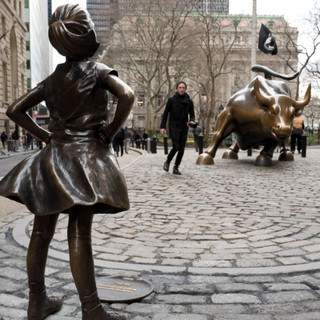



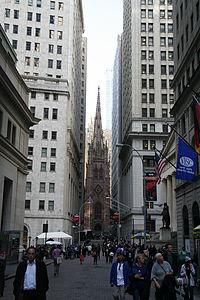

























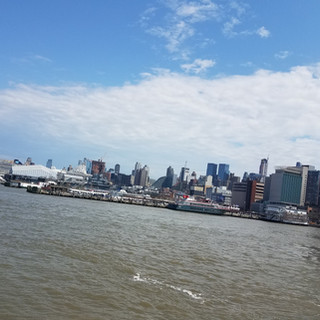







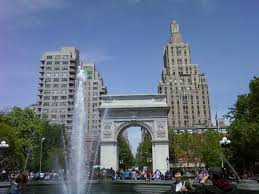










































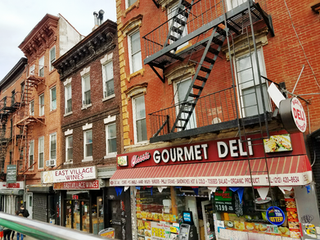



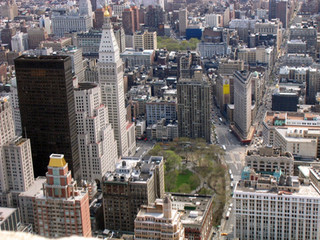









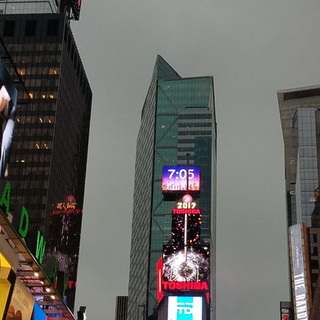















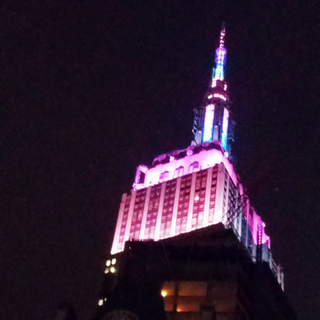







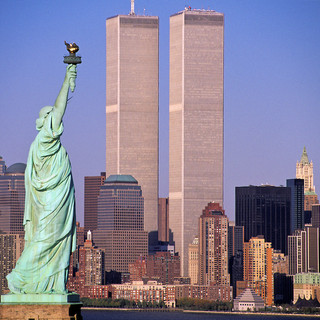









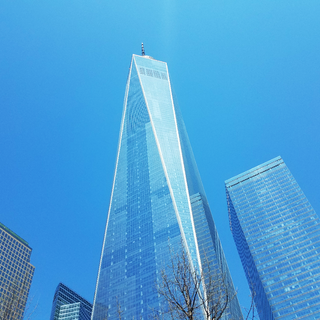

























Comments